Mexico has its fair share of natural wonders. It’s a big country and has a lot of different natural environments to be explored. There are deserts, jungles, mountains and coastal areas, plus the opportunity to see wildlife. Most people go for the ruins, and while there are some truly incredible ruins (check out my favourites here), the natural spots are just as incredible and well worth your time.
The natural wonders in this list are what I visited and what I think was the best of nature. There are breathtaking views, spectacular canyons, pristine water swimming spots and hard to get to places. Some of the places on this list have been voted into the list of 13 Natural Wonder of Mexico, and one is listed as one of the 7 Natural Wonders of the World.
So, without further ado, here’s my top natural wonders of Mexico that you don’t want to miss:
1. Peña De Bernal
Located in the village of San Sebastián Bernal (often referred to simply as “Bernal”), Peña de Bernal is one of the tallest Monoliths in the world. The monolith towers over the town, standing at 433m tall. Peña de Bernal is one of the natural wonders in Mexico to be voted in the top 13.
You can easily see the monolith from the village of Bernal and it’s easy to walk to the base (or get a taxi). It is also possible to climb this volcanic rock. You climb to about two-thirds of the way up on a well-marked (and well-trodden) path. The last third can only be climbed by rock climbers (if you want to try the lasty third, check out this tour). The climb up to the two-thirds point isn’t too hard and doesn’t take too long. I saw many Mexican holidaymakers walking up with a michelada in hand!.
To get to Peña de Bernal on your own you can take a bus from Querétaro (though I found getting the bus back is a little bit of guesswork!) Alternatively, you can book a tour from Mexico City.


Peña de Bernal
2. Hierve Al Agua
Found in the state of Oaxaca, Hierve Al Agua is a popular destination.
Hierve al Agua is a “frozen waterfall”. Though it is not actually a waterfall at all. Instead, it is a mass of calcified rock. Water with a very high mineral concentration comes out of the ground in springs at the top of the falls. The water then trickles down and mineral deposits are left behind, similar to the way stalactites are formed in caves.
The views from the top of the waterfall are incredible and you can swim in the pools at the top. A short walk from the pools, through the forest, and you will find a great viewpoint to see the rock formation.
You can reach the waterfall from Oaxaca, but it is not the easiest. First you need to get a bus or colectivo to Mitla and then another colectivo to Hierve Al Agua. It is much easier to see this natural wonder on a tour, on which you will see more of the Oaxaca area. You can check out some tours here.
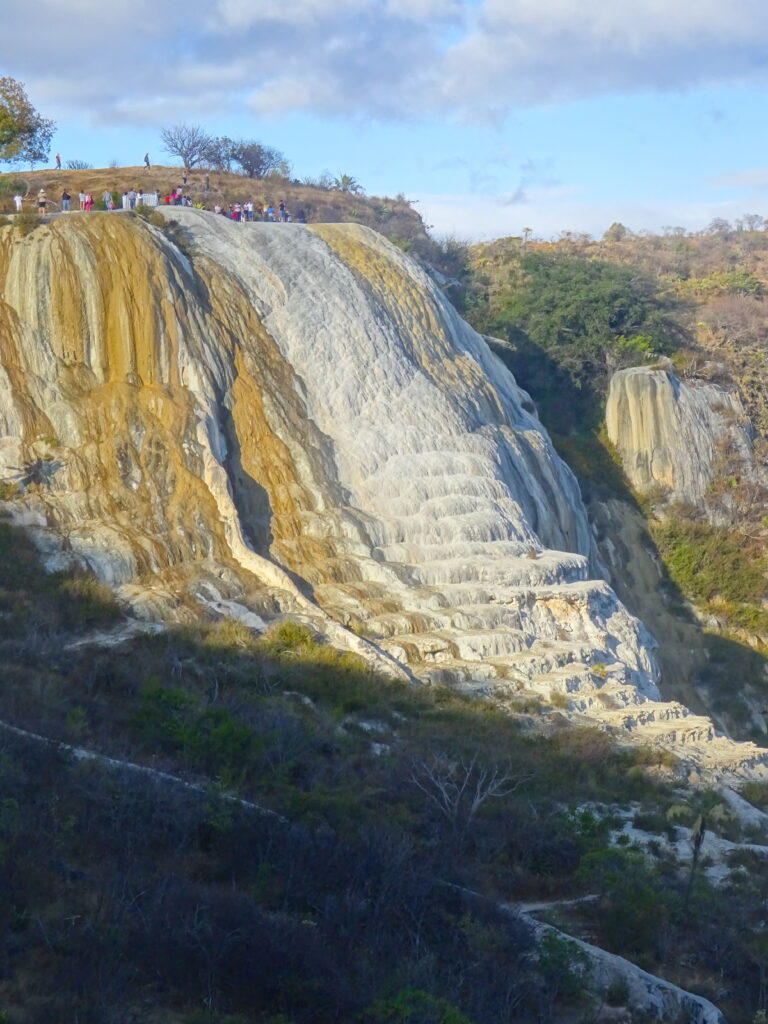

The “Frozen Waterfall” Of Hierve al Agua
3. The Copper Canyon
Another one listed in the 13 Natural Wonders of Mexico, the Copper Canyon region is well worth a visit. Mainly in the state of Chihuahua, there is a lot to see in this incredible canyon.
The canyon is actually six canyons, made by six rivers that merge into El Fuerte. The main gorge is over 2000m deep and if you include the whole area it dwarfs the Grand Canyon.
For visiting, there are several ways to see the canyon. There is a railway, you can hike and buses connect the towns. Whatever you decide, you will need at least a couple of days and the longer you have te better. You should see the three main canyons (Urique, Copper and Tararecua), which can be seen from the Three Canyons Viewpoint. I would also recommend going into Urique and definitely do the railway from El Fuerte to Bahuichivo.
Personally, I did a multi-day trip, with Copper Canyon Adventures, which you can read about here. I really loved their Create A Trip!
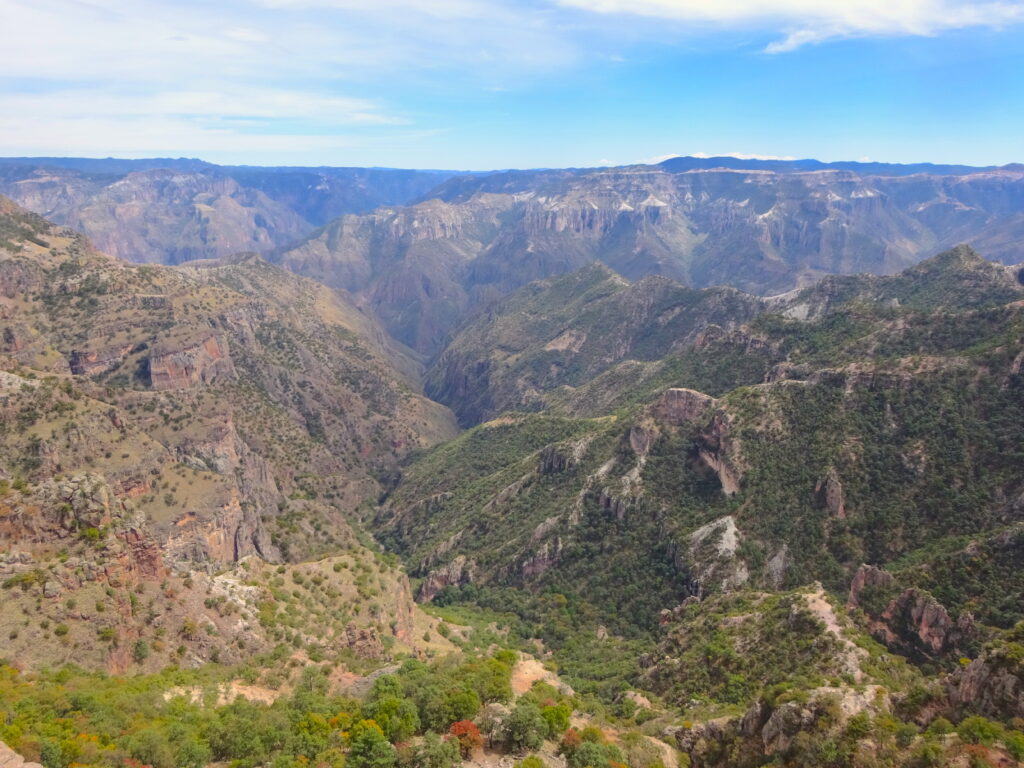

Three Canyons Viewpoint In The Copper Canyon
4. Paricutin
Paricutin is one of Seven Natural Wonders of the World. But be aware, this is not an easy place to get to!
This extinct volcano is found in the state of Michoacán, the nearest city is Uruapan. This is the only volcano where humans have witnessed the entire life cycle. The volcano came to life during the 1940s and was active for nine years. During its life, the cinder cone rose to 424m and caused damage over an area of 90 square miles.
To see this volcano, you can get a bus from Uruapan to the town of Angahuan. From there you have to hire a guide with horses to reach the volcano. You can climb to the top of the cinder cone or just ride to the area. Either way, don’t miss the ruined church of San Juan Parangaricutiro, which looks like a dragon’s lair.
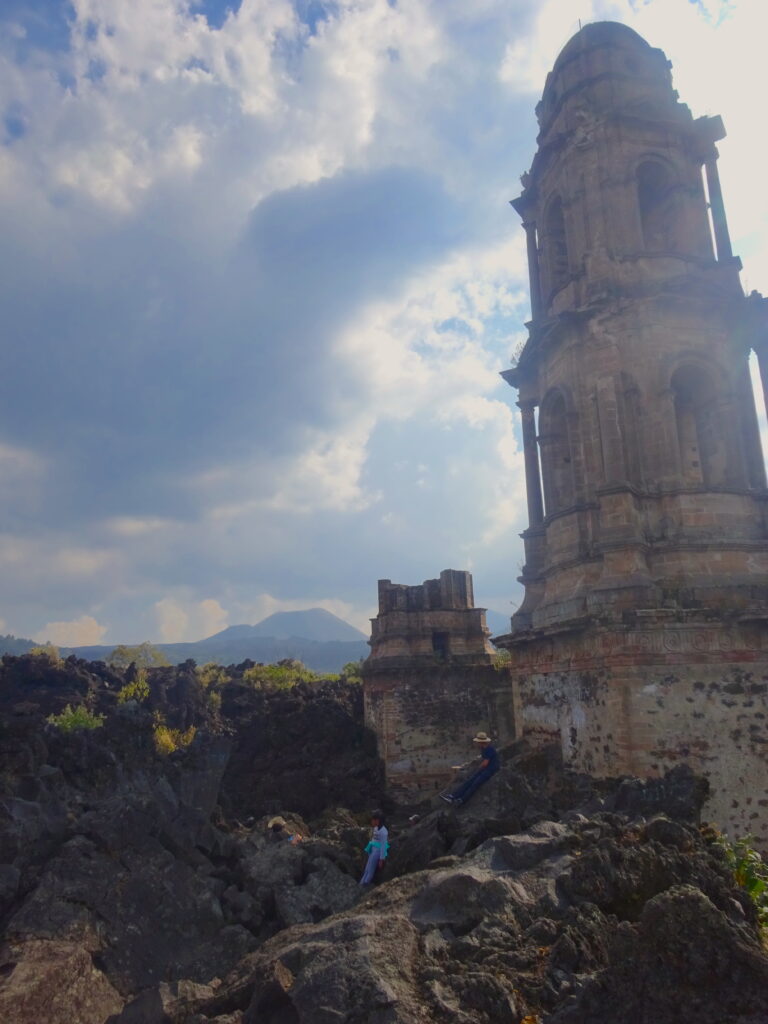

San Juan Parangaricutiro And Paricutin Volcano
5. Barranca Huenti
Located on the outskirts of Guadalajara, Barranca Huenti (also known as Barranca de Oblatos), is a great place to experience some nature when exploring the city. The canyon is a biogeographic corridor due to the different types of vegetation found here.
From the top of the canyon, the views are breathtaking. You can hike down the gorge, a winding path takes you down the 600m to the river at the bottom. During the hike, you cross an old rail line, which I saw some people climbing up and down, but I’d recommend sticking to the path! Though if you stand in the rail line, the view is amazing. If you’re not up for climbing all the way down, I’d at least go this far.
If you climb down though, be aware the climb back up is gruelling. The steep canyon is not easy to climb in the hot Mexican sun. So take plenty of water and sun cream!
To get to Barranca Huenti, you need to catch a bus from Guadalajara city to Barranca de Huentitán. From there it’s pretty easy to find the trail down.
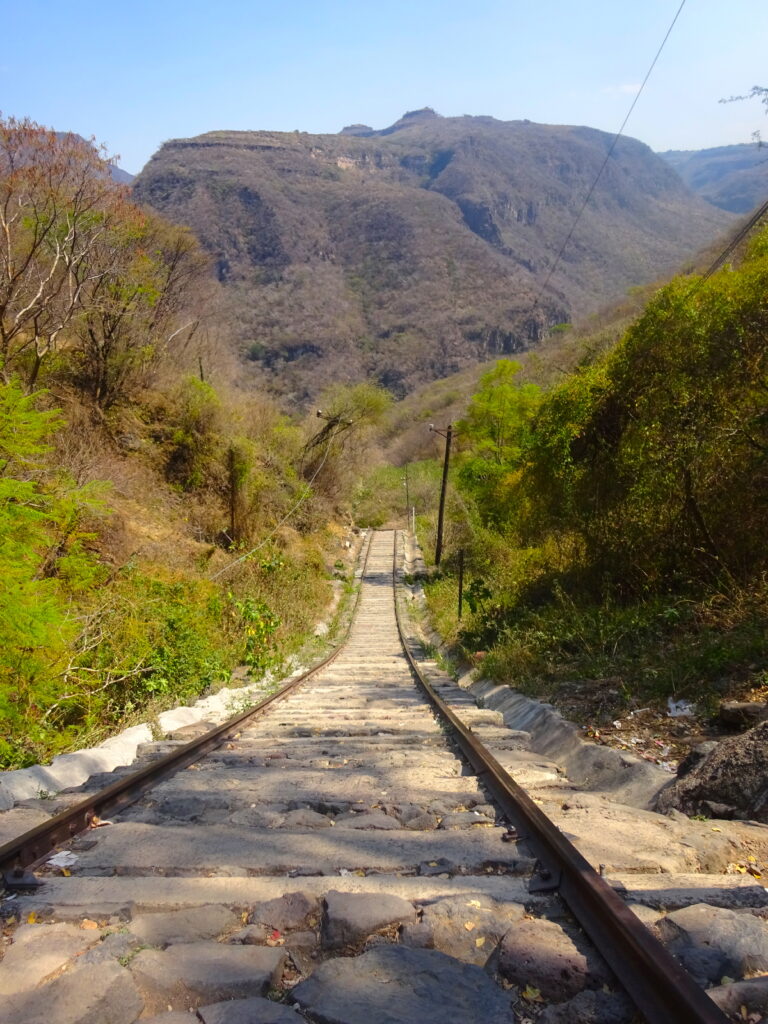

Looking Down The Railroad Track At Barranca Huenti
6. Agua Azul
Not far from Palenque you can find this natural wonder of Mexico. Agua Azul is a series of waterfalls, with pools of beautiful turquoise water.
Part of the Xanil River, the waters here have a high content of calcium carbonate, which gives them their stunning colours. Where the water runs over rocks and trees, some of the mineral content is left, giving a think limestone covering.
From the car park, you can walk up to quieter rapids 1km upstream. The views are worth the walk, it’s not difficult or far at all. Though if you want to swim, stick to the first pool and be careful of the currents.
This waterfall is on the route from Palenque to San Cristobal de las Casas and so many colectivos will take you there on the journey from one city to the next. You can also take a tour from either city.
You can read about my visit to these waterfalls here.
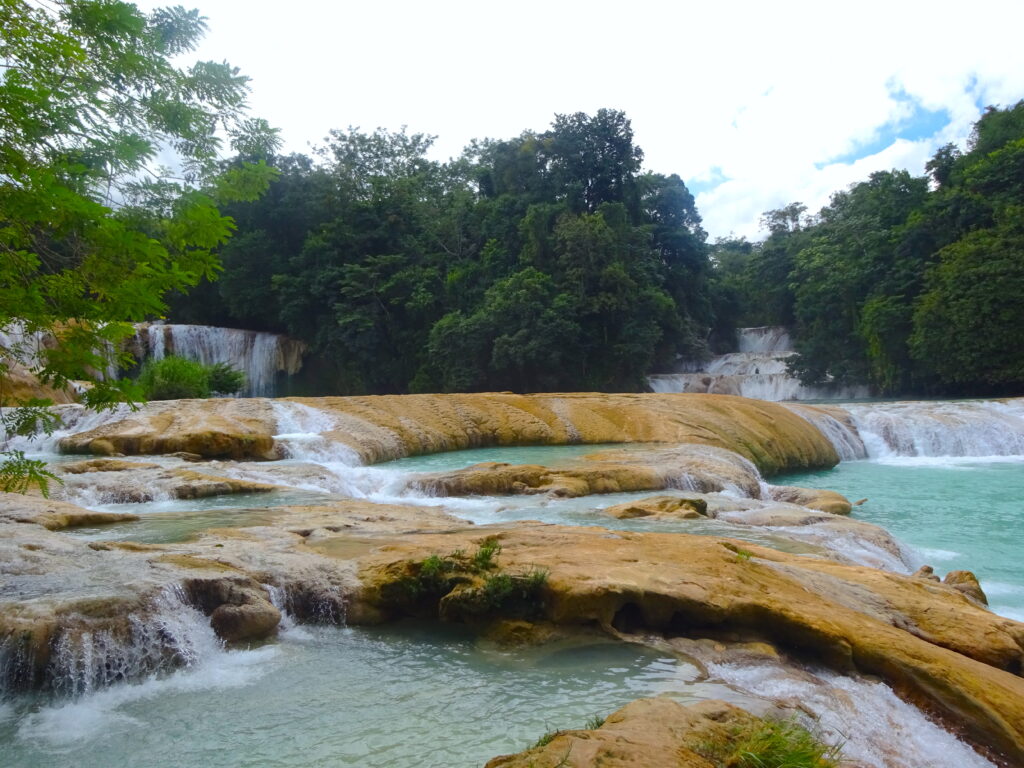

Agua Azul Waterfalls
7. Cenotes
This next natural wonder of Mexico is not just one place. Cenotes are sinkholes found all over the Yucatan Peninsula. There are over 6,000 of them! I think I managed to visit about 30 in total during my time here.
There are different types of cenotes. Some are dried up, others are underground pools. They can be completely underground or have a hole in the top of the cave, others are completely open. You can find them in the middle of nowhere and can be difficult to get to, or in a city, such as Valladolid. There’s even a cenote at Chichen Itza. If you visit the peninsula, chances are you will visit at least one.
Each cenote has its own draw. They are all beautiful in there own way, so visit as many as you can! Some were sacred to the Mayans, some have fish in them, some are quiet and others are very popular tourist sites.
As there are so many to see, I can’t really give you directions, it depends where you go from. There are loads near Merida, Tulum, Cancun and Valladolid. You can take a look at some tours that include a cenote swim here.
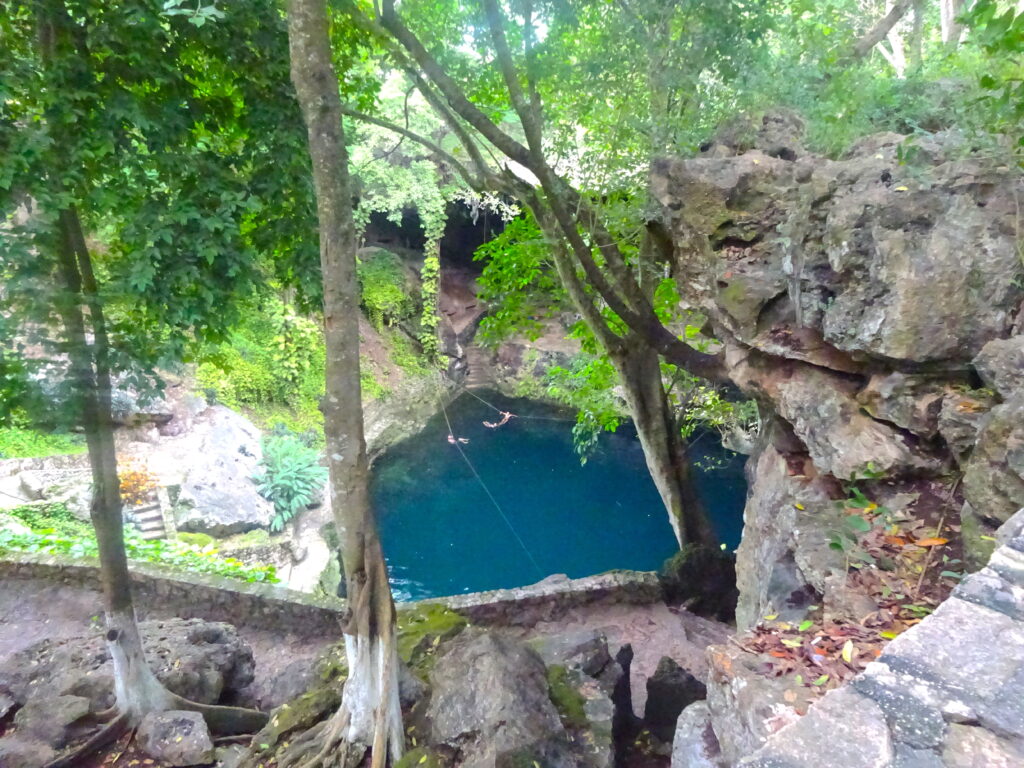

The Canote In The City Of Valladolid
8. Las Coloradas
The famous pink lakes of Mexico are called Las Coloradas and are, kind of, a natural wonder. I say kind of as these are actually salt evaporation ponds and the colour comes from the bacteria in the water. These are found to the north of the Yucatan Peninsula.
Though I will say, some of the pictures you see online are a little deceptive. Firstly, you can not swim in the pink lakes, they are private land. Also, they’re not as pink as some of the images would have you believe. But they are still worth visiting. They are found in the biosphere reserve of Río Largartos, which is considered a unique habitat. This biosphere reserve is a popular bird-watching site, you can see flamingos and a variety of rare animals.
There is no public transport to Las Coloradas. The nearest place you can get to is Río Largartos, a small fishing village. From here you will have to take a tour into the biosphere reserve to see Las Coloradas. I did a tour from Valladolid, as apparently the public transport to Río Largartos isn’t the best.
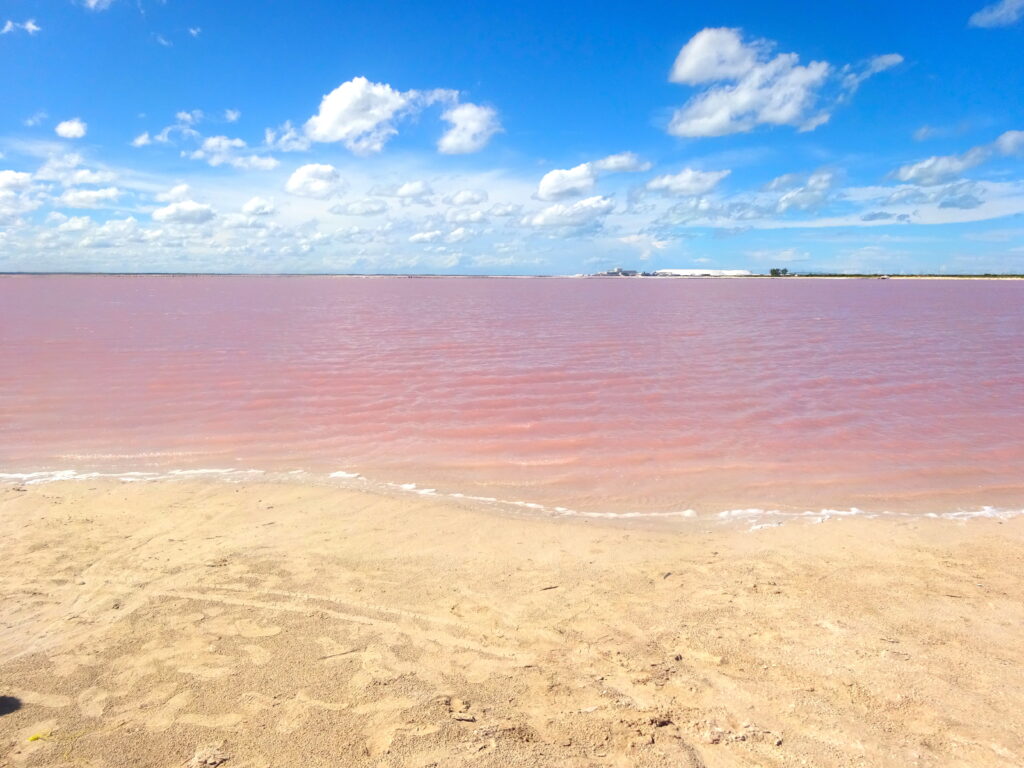

Pink Lakes Of Las Coloradas
9. Prismas Basalticos
In the state of Hidalgo, this is another place that made the list of 13 Natural Wonders of Mexico, according to a vote, it is called Prismas Basalticos.
These basalt columns line the walls of a ravine called Barranca de Santa María Regla and are now housed in a park. The columns are between 30 – 50m tall and have five or six sides. They were created by the slow cooling of volcanic lava. This geographic feature that has been created is known as columnar jointing.
Two waterfalls cascade over the columns, giving an impressive sight. Stairs and bridges have been added here, so you can see the Prismas Basalticos easily from several viewpoints.
To see these impressive basalt columns on your own, catch a colective to Huasca de Ocampo from Pachuca. You will need to take a taxi from this town to the park itself. Alternatively, you can see the prisms and more on this tour.
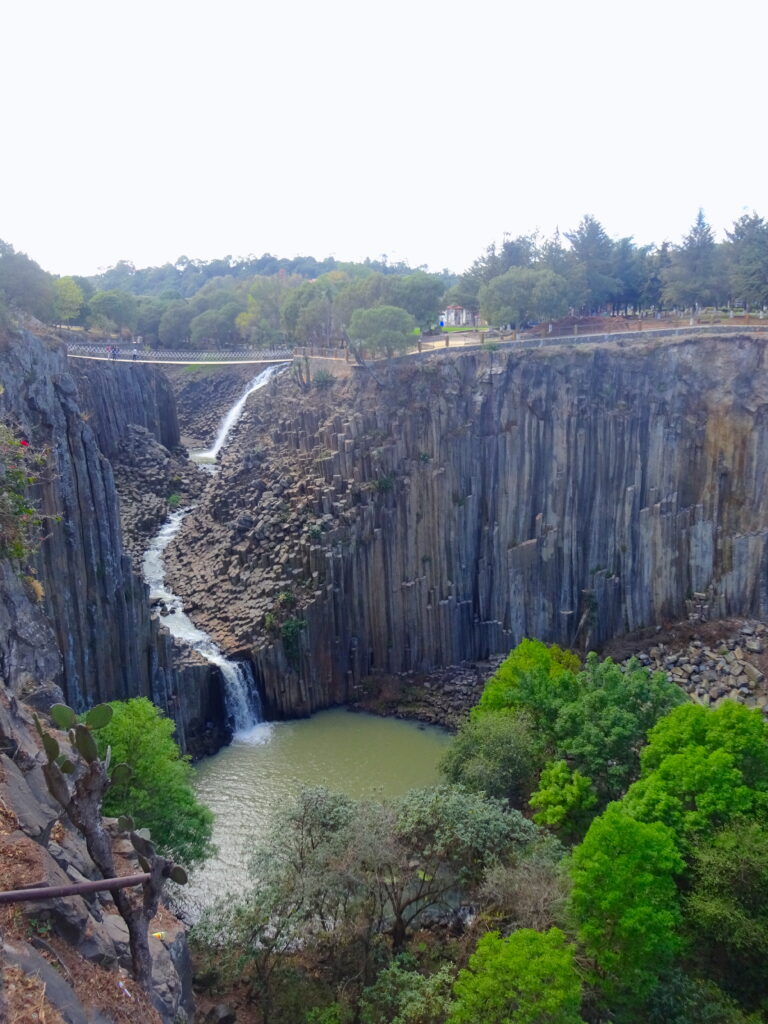

The Prismas Basalticos
10. Lagunas De Montebello
Known as the Lake District of Mexico, Lagunas de Montebello is a national park in the state of Chiapas, near the border to Guatemala.
This national park is filled with wooded countryside studded with fifty-nine lakes and is a UNESCO site. Due to varying mineral content, the lakes have a range of stunning colours. Some lakes you can see from viewpoints, others you can explore by a small boat with a local guide.
Discover more UNESCO World Heritage Sites in Mexico
You can reach the lakes from Comitán, where buses and colectivos run from to the park. Buses also take a route around the park, so you can get off at different viewpoints. Though be aware of the last bus from in the park. You can also stay in or near the park if you want more time to explore.
Another option is to take a tour from San Cristobal de las Casas, which is what I did. I did something similar to this tour.
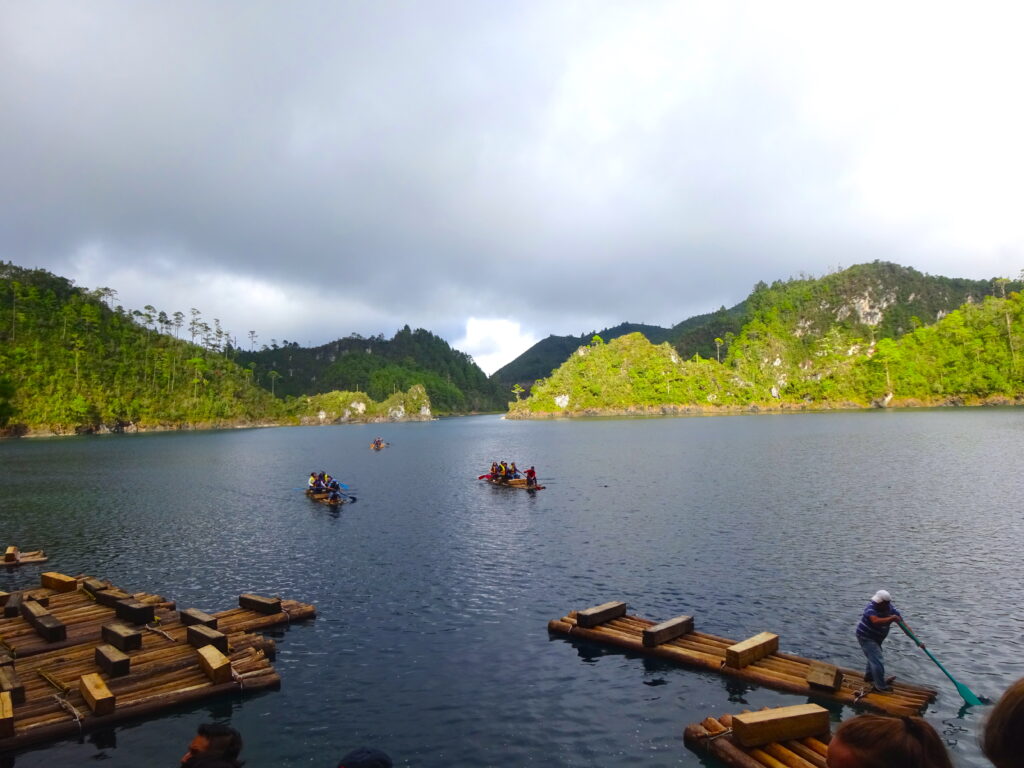

Local Boats At Lagunas De Montebello
11. Grutas Nombre De Dios
On the outskirts of Chihuahua city, you can find the incredible caves of Grutas Nombre de Dios.
In the caves are some incredible rock formations. To see them you need to take a tour, as it’s the only way into the cave system. Inside you will see formations such as the “Food Room”, “Castle, Dragon and Knight”, and the “Love Room”. The tour takes about an hour and extends over 1,450m in length and descends over 80m. Most of the formations are made from limestone and have been created by water seeping through the cave.
To get to the caves you need to take a taxi from the Chihuahua city centre. There is no public transport here.
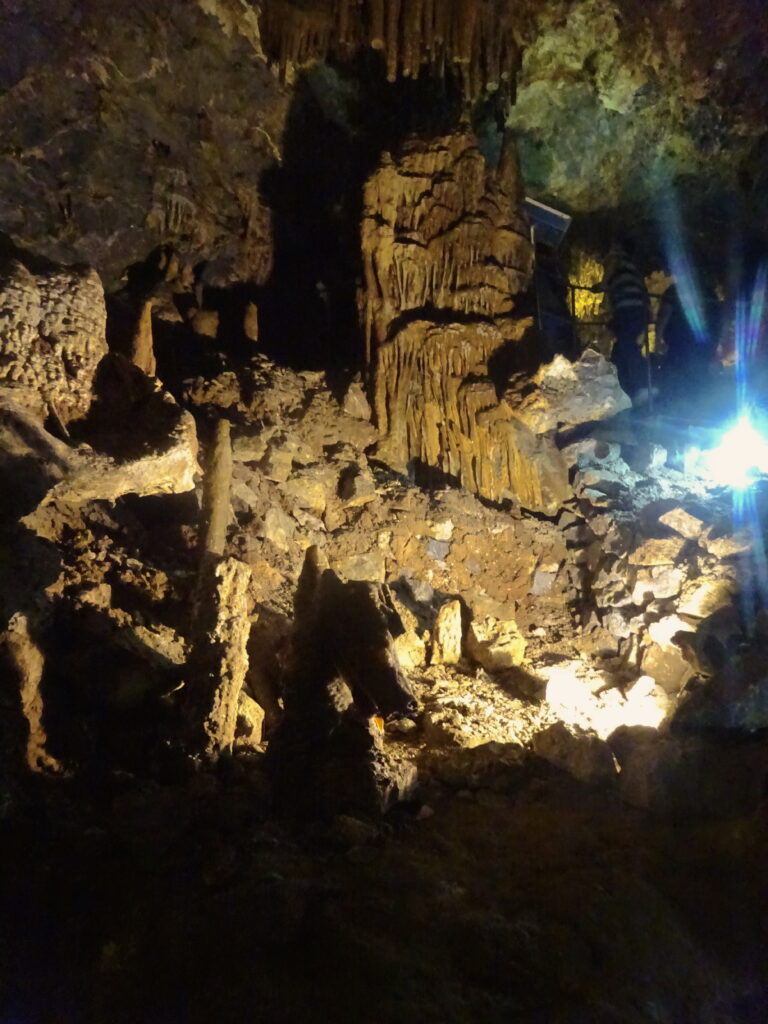

Dragon, Knight And Castle Formation In Grutas Nombre De Dios
12. Sumidero Canyon
From San Cristobal de las Casas you can reach the popular tourist destination of Sumidero Canyon. This canyon also made the Thirteen Natural Wonders Of Mexico list.
The canyon was made by the erosion from the Grijalva River. You can get a boat on this river to see the canyon and it is awe-inspiring. The canyon walls reach as high as 1,000m above your head as you are taken down the river. As you are taken along the river you will likely see monkeys and crocodiles. You will also have notable features pointed out to you, such as the chapel and “Christmas Tree Waterfall”.
Though this is a natural wonder of Mexico, I do have to point something out before you visit. The rubbish in the river is as incredible as the canyon itself, albeit in a negative way. I was absolutely heartbroken to see a crocodile happily laying on an island of plastic bottles. So although it is a beautiful area, be aware that it is a juxtaposition of a disgusting place too.
To visit you can get a bus from Tuxtla, though the boats will only go when there are enough people, so you may have to wait for tour groups. There are also a range of tours available from both Tuxtla and San Cristobal, which is the easiest way to get to the canyon. Have a look at available tours here.
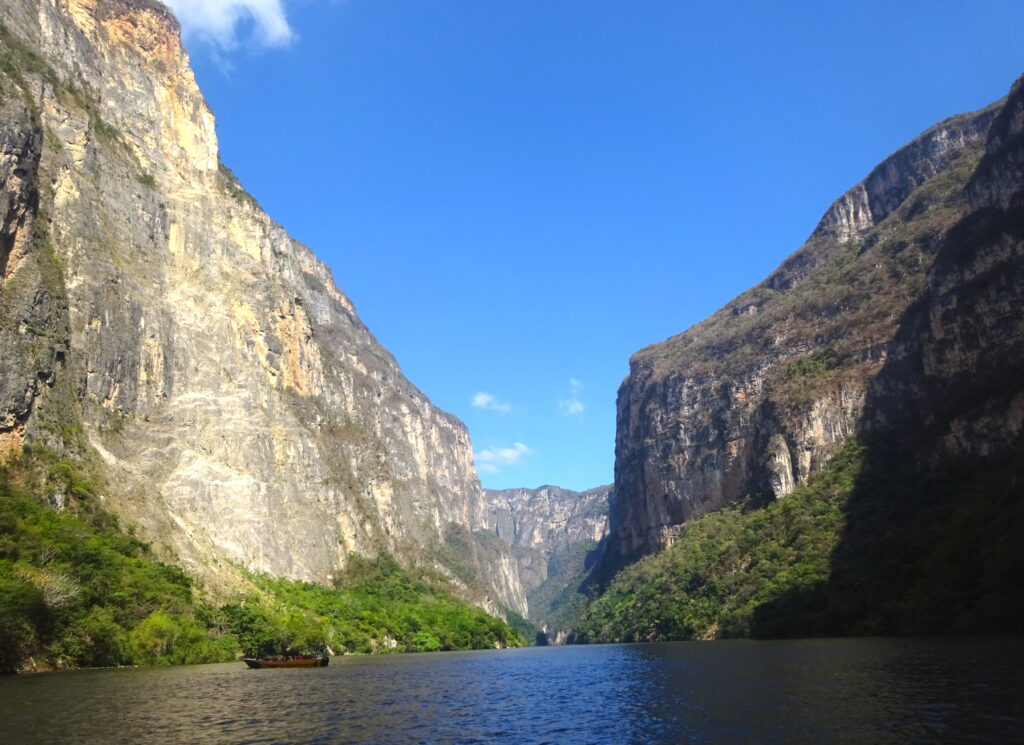

Sumidero Canyon From The River
13. Tule Tree
Not far from Oaxaca, on the road to Mitla, is the town of Santa María, in the church grounds of this town you will find the Tule Tree.
This tree is one of the oldest living things in the world. It is a rare Montezuma cypress (taxodium mucronatum). It was once thought to be more than one tree, but it is now known to be one tree. With a trunk diameter of 14m, it is the widest tree in the world. The tree itself is thought to be 2,000 years old. The spot where the Tule tree is found was a sacred spot to the local Zapotec, their legend states that it was planted by a priest 1,400 years ago. Animals can also be seen in the trunk, giving the tree the nickname of “the tree of life”.
This tree is easy to get to from Oaxaca, you can easily catch a bus from Oaxaca. Alternatively, many tours that go to Hierve Al Agua also go to the Tule Tree, such as this one.
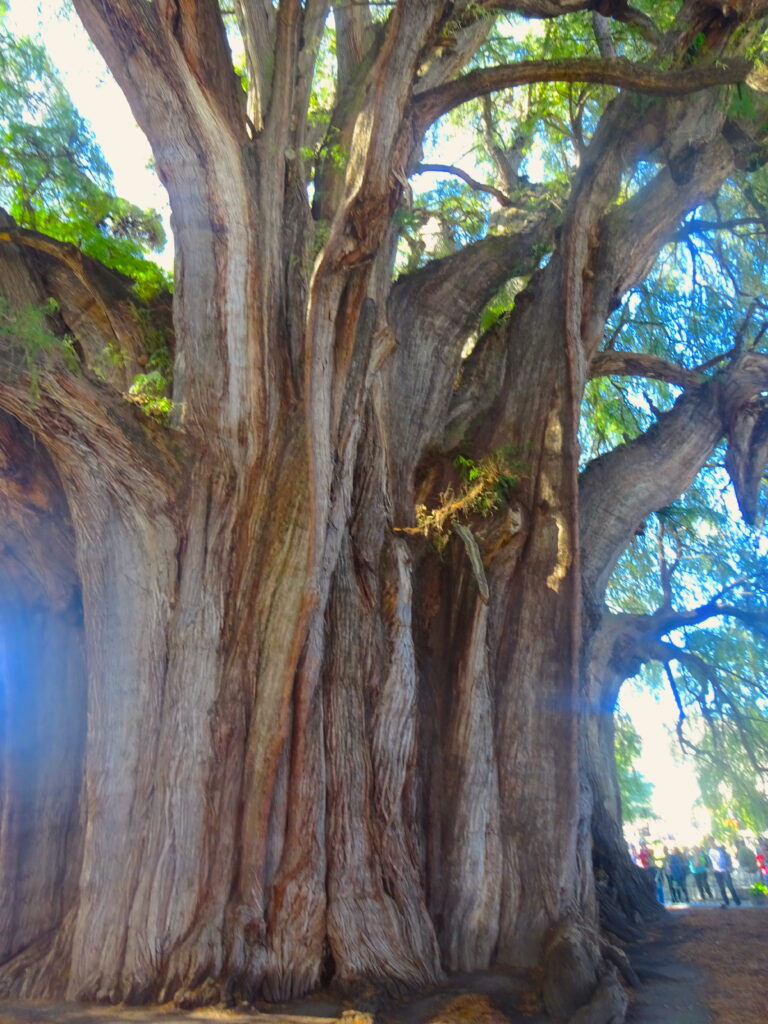

The Tule Tree
14. Lake Bacalar
Lake Bacalar is a bright blue lake in the state of Quintana Roo.
The lake is long and narrow, it’s not even 2km across at its widest point, and is 42km long. Because of its limestone bottom, the lake is a striking blue colour. The blues changes at different points, so it is known as the Lake of Seven Colours.
Here you will also find stromatolites, which are some of the oldest life on the planet. You can access the lake at different points for a swim or kayak on it (read my review of a full-day tour here). One the lake there are several points of interest such as the Pirates Channel and the Black Cenote.
To visit you can stay in the town of Bacalar and explore at your own leisure. Personally, I took a tour from Chetumal, you can read about my adventure in this post. If you’re not planning on staying in Chetumal or Bacalar, take a look here for a range of tours from different locations on the Yucatan Peninsula.
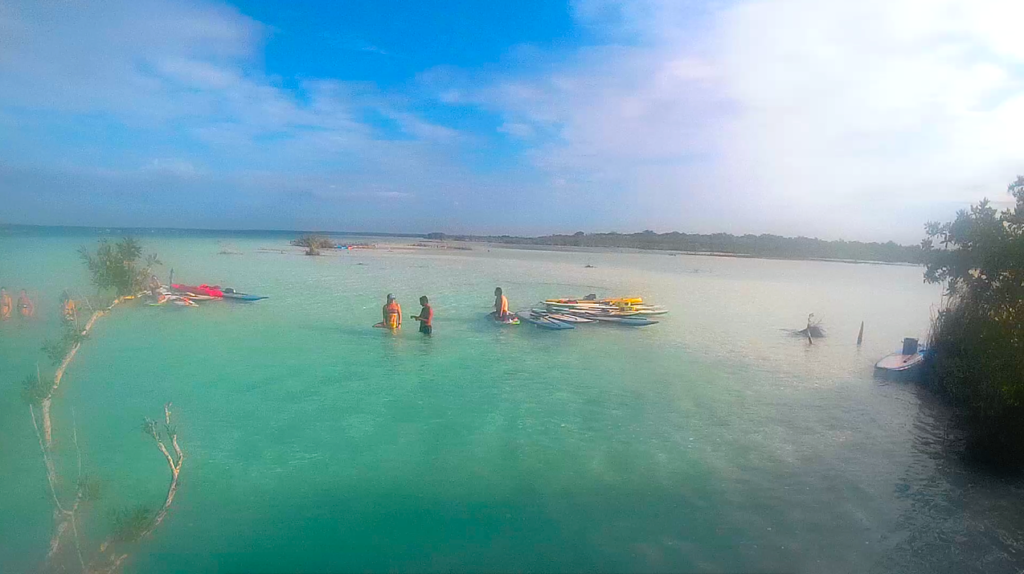

Pirates Channel On Lake Bacalar
15. Las Ánimas
The only beach to be included in my natural wonders of Mexico list. Playas Las Ánimas is a scenic beach not far from Puerto Vallarta in the state of Jalisco.
Though like all beaches, on busy days it can get very “touristy”, with banana boats, hoards of day-trippers, the coastal restaurants and people trying to sell you anything and everything. One less busy days it is a lovely, quiet and beautiful stretch of ocean.
To explore this beach you have to get a water taxi from Boca de Tomatlán, or you can hike from this area. Personally I recommend the hike and then get a water taxi back. The hike is stunning, you go along the coast through wooded areas, across a small beach, back into wooded cliffs until you come to the beach. You need decent footwear for this hike, the path isn’t always the best. But as it goes along the coast it’s pretty easy to follow.
To get to Boca de Tomatlán there is a bus from Puerto Vallarta. From there you can hike or get a water taxi. Alternatively, this tour includes time at Las Ánimas.


16. Misol-Há
Another waterfall that you must see near Palenque is Misol-Há.
This waterfall is a single drop of 35m. The water drops into a single, almost perfectly circular, pool at the bottom, which is safe to swim in. There is also a path that leads to the back of the waterfall (though it is slippery, so be careful when going back here).
Surrounded by lush vegetation, this waterful is certainly picturesque. The waters are also blue, like the nearby Agua Azul, due to the mineral concentration in the water.
As this waterfall is practically up the road from Agua Azul, the transport here is much the same. Most colectivos will stop en route between Palenque and San Cristobal de las Casas. Or you can visit on a tour from either city.


The Waterfall Of Misol-Há
17. La Bufadora
Not far from Ensenada on the peninsula of Baja near the border to the USA, you will find La Bufadora or The Blow Hole .
This is the second-largest blowhole in the world and the only one found on the American continent. Air is trapped in a sea cave, due to wave action. As the waves recede, the air explodes out, causing the water to be pushed up to 100m above sea level. If you stand too close you will get soaked. I highly recommend coinciding your visit with high tide, so that the ejection of water is at it’s highest.
Be aware, although this makes my natural wonders of Mexico list and is an awesome thing to see, from the car park you have to run essentially a gauntlet. The way to the blowhole is lined with shops and restaurants, all desperately trying to drag a tourist in. Like all places like this, there are pickpockets, so watch everything.
To get to La Bufadora you will need to catch a collective or a taxi from Ensenada. You can catch a bus, but you have to go to Macheros, where you then catch another bus to La Bufadora.
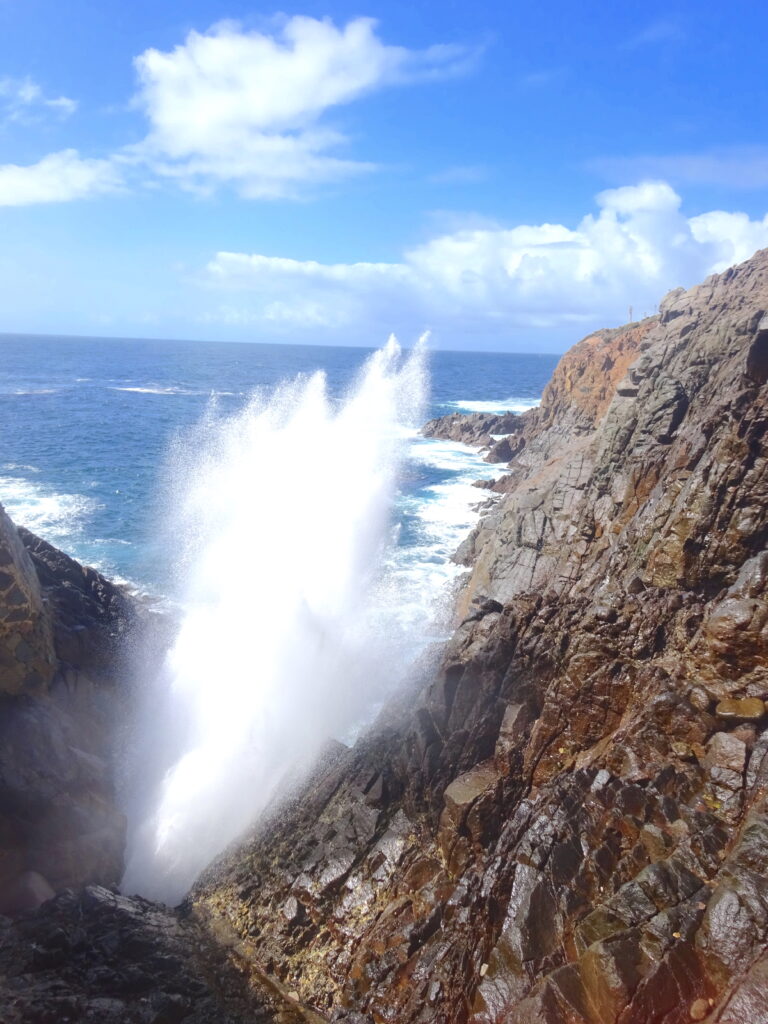

La Bufadora, The Blowhole
18. Cascada El Chiflón
For my last natural wonder of Mexico, we have another waterfall. This one is the Chiflón waterfall, in the state of Chiapas.
This impressive waterfall drops around 120m in total over a series of falls, the largest of which is 70m. The turquoise cascades are surrounded by lush vegetation, making it a stunning sight. You can climb up the side of the falls, following a track and get close, but you will get soaked.
To get to El Chiflón, you can catch a bus from San Cristobal de las Casas to Comitan. From Comitan you will need to catch a colectivo to the waterfalls. Another option is a tour. Tours to El Chiflón usually include Lagunas de Montbellos too, like this one.


Chiflón Waterfall
Mexico definitely has a lot of natural wonders to visit, these eighteen are just my personal favourites. Have you been to any of these? Let me know what you thought in the comments below.
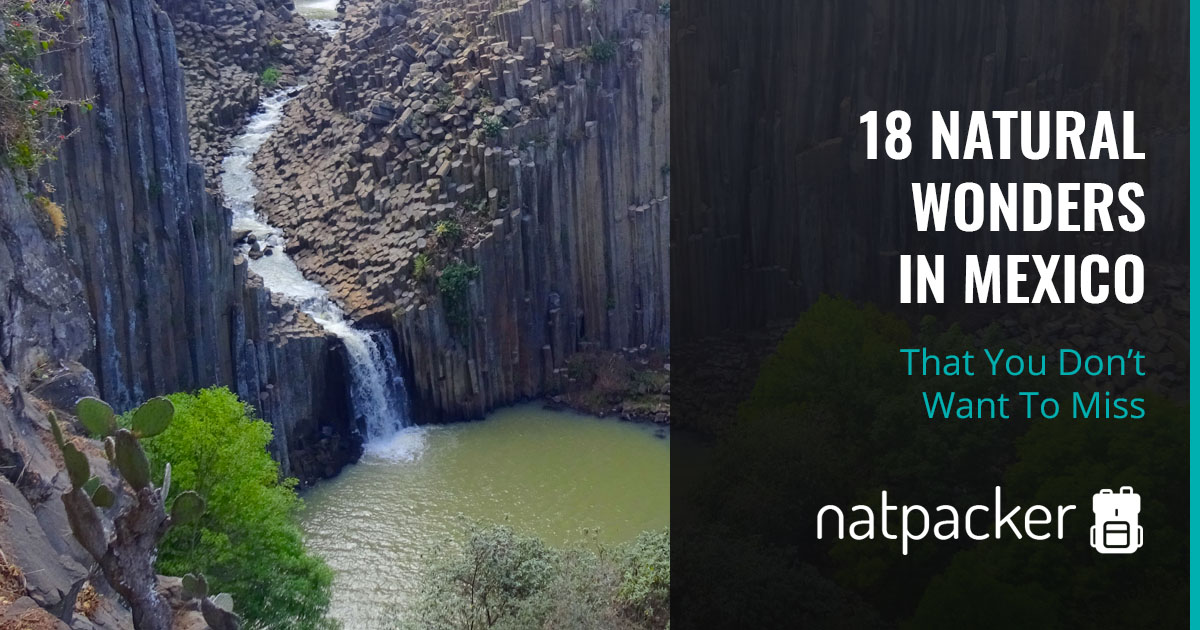

8 Comments
There’s so much to see here
Definitely! Mexico is huge with lots to see.
Hey Nat,
These are really wonderful places to explore in Mexico. Loving these beautiful photographs. Thanks for sharing these places.
Beautiful places in Mexico to visit, great article.
Thanks for providing such a resourceful info about the place. It’s insightful. Got to know some amazing facts.
I’m glad you enjoyed it 🙂
“Mexico is truly a treasure trove of natural wonders! From the stunning cenotes to the majestic Copper Canyon, each of these 18 wonders is a testament to the country’s natural beauty and diversity. Adding these to my must-visit list for sure!
Mexico has so many beautiful spots! I hope you get to visit some in the future 🙂